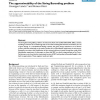Free Online Productivity Tools
i2Speak
i2Symbol
i2OCR
iTex2Img
iWeb2Print
iWeb2Shot
i2Type
iPdf2Split
iPdf2Merge
i2Bopomofo
i2Arabic
i2Style
i2Image
i2PDF
iLatex2Rtf
Sci2ools
ALMOB
2006
2006
The approximability of the String Barcoding problem
The String Barcoding (SBC) problem, introduced by Rash and Gusfield (RECOMB, 2002), consists in finding a minimum set of substrings that can be used to distinguish between all members of a set of given strings. In a computational biology context, the given strings represent a set of known viruses, while the substrings can be used as probes for an hybridization experiment via microarray. Eventually, one aims at the classification of new strings (unknown viruses) through the result of the hybridization experiment. In this paper we show that SBC is as hard to approximate as Set Cover. Furthermore, we show that the constrained version of SBC (with probes of bounded length) is also hard to approximate. These negative results are tight. Background The following setting was introduced by Rash and Gusfield in [1]: Given a set V of n strings v1,...,vn (representing the genomes of n known viruses), and an extra string s (representing a virus in V, but not yet classified), we aim at recognizing ...
| Added | 10 Dec 2010 |
| Updated | 10 Dec 2010 |
| Type | Journal |
| Year | 2006 |
| Where | ALMOB |
| Authors | Giuseppe Lancia, Romeo Rizzi |
Comments (0)

